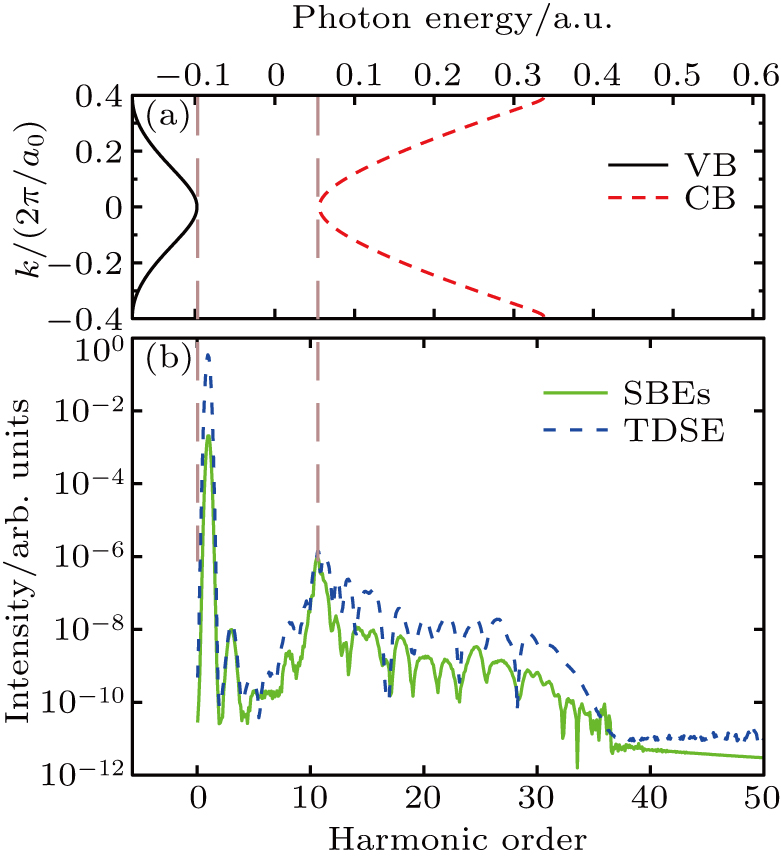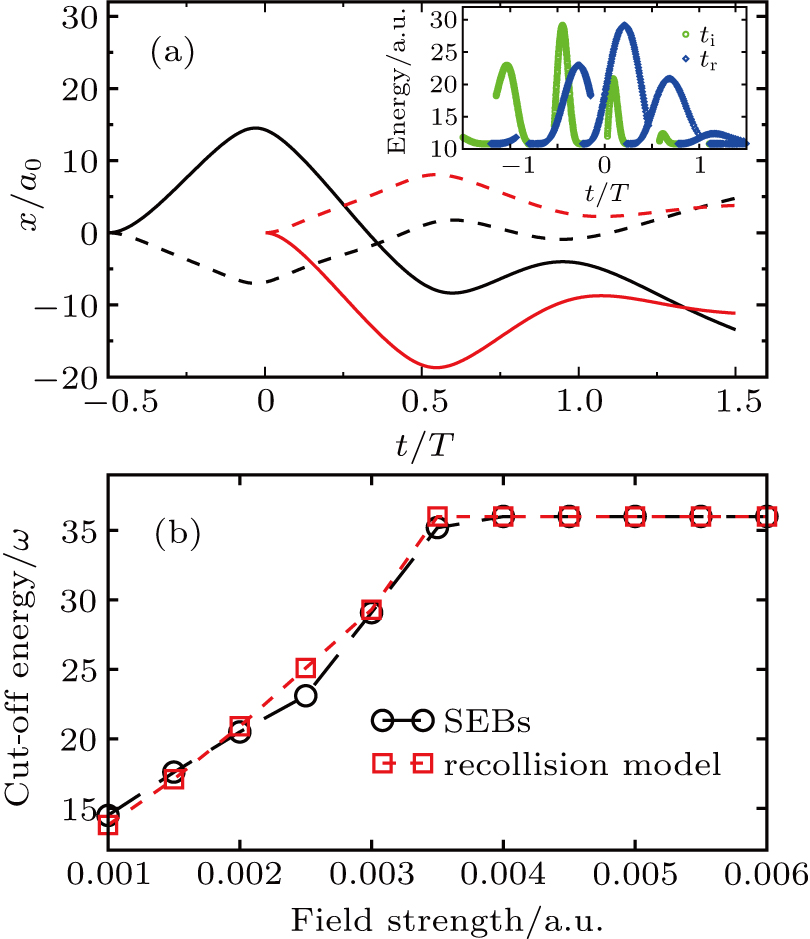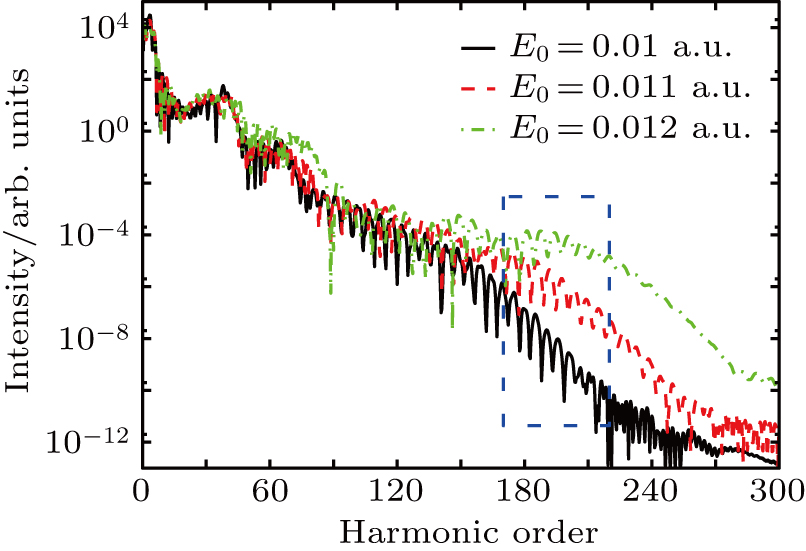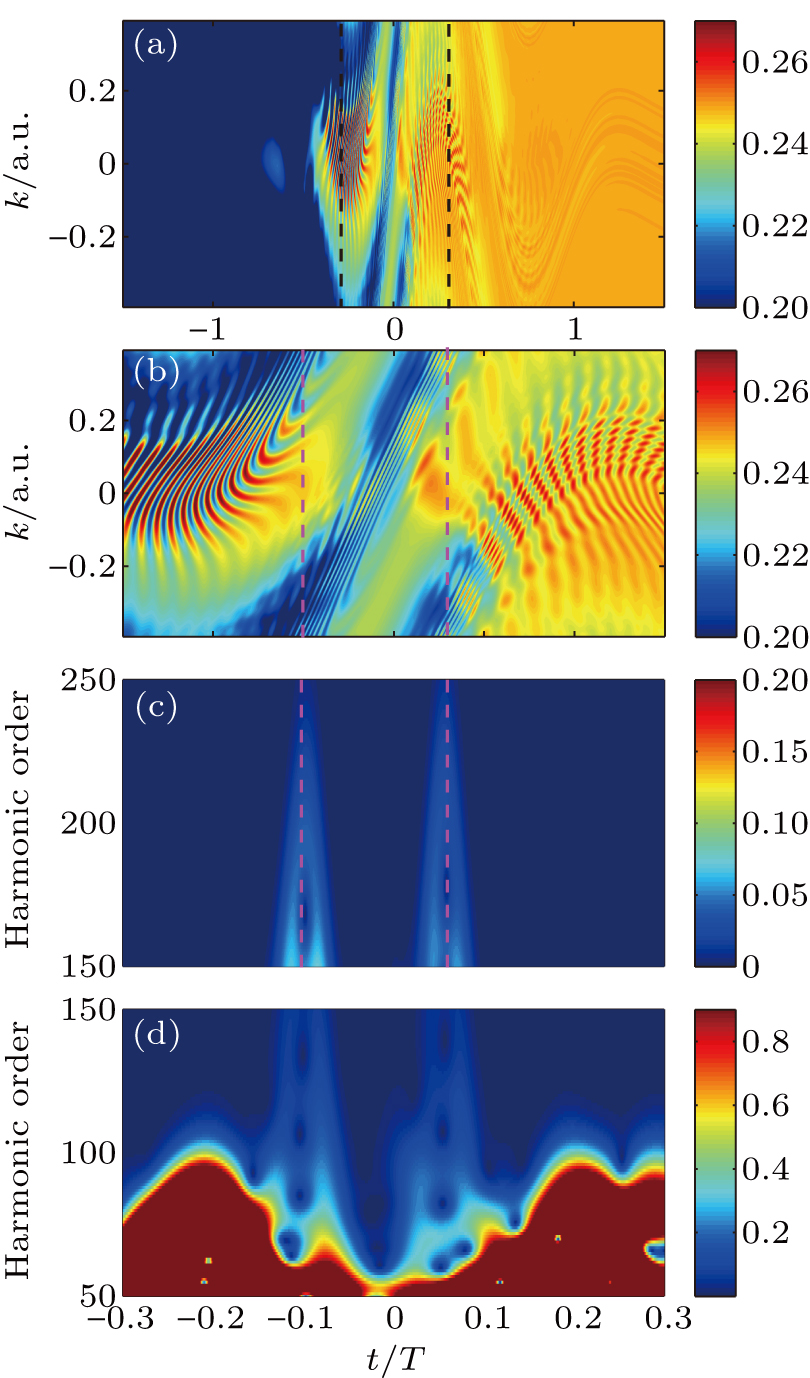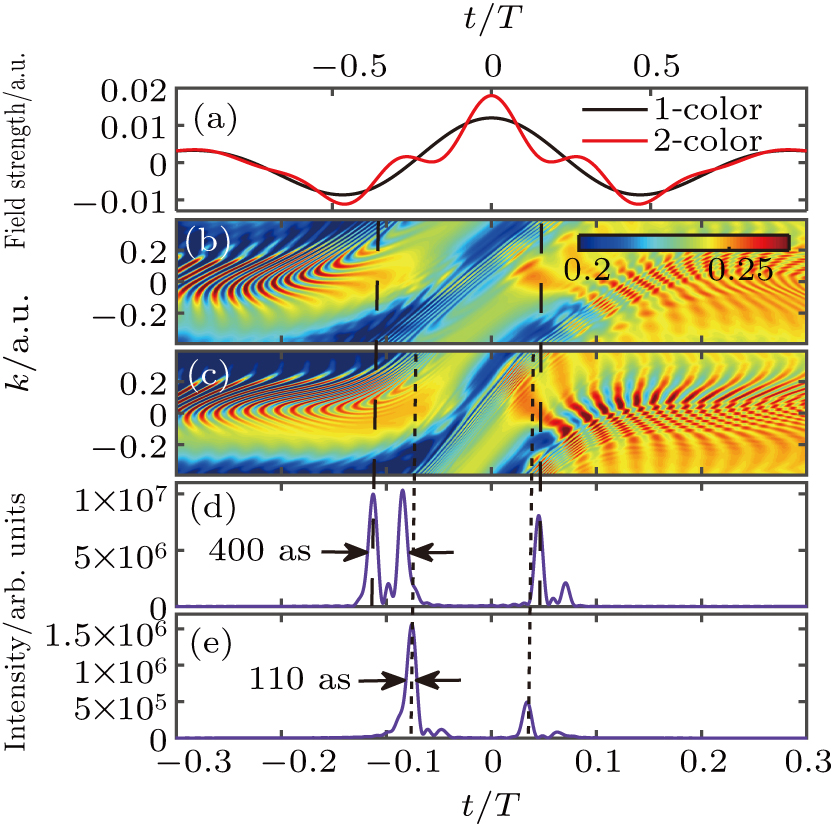Project supported by the NSAF, China (Grant No. U1730449) and the National Natural Science Foundation of China (Grant Nos. 11904341, 11774322, 91850201, and 11874066).
Project supported by the NSAF, China (Grant No. U1730449) and the National Natural Science Foundation of China (Grant Nos. 11904341, 11774322, 91850201, and 11874066).
† Corresponding author. E-mail:
Project supported by the NSAF, China (Grant No. U1730449) and the National Natural Science Foundation of China (Grant Nos. 11904341, 11774322, 91850201, and 11874066).
The high-order harmonic generation from a model solid structure driven by an intense laser pulse is investigated using the semiconductor Bloch equations (SBEs). The main features of harmonic spectrum from SBEs agree well with the result of the time-dependent Schrödinger equation (TDSE), and the cut-off energy can be precisely estimated by the recollision model. With increasing the field strength, the harmonic spectrum shows an extra plateau. Based on the temporal population of electron and the time–frequency analysis, the harmonics in the extra plateau are generated by the Bloch oscillation. Due to the ultrafast time response of the Bloch electron, the generated harmonics provide a potential source of shorter isolated attosecond pulse.
High-order harmonic generation (HHG) is a non-linear process when atoms, molecules, or plasmas[1–4] are illuminated by an intense laser pulse. HHG is a prerequisite of attosecond pulse[5] due to the coherent nature, which can also be used to investigate the ultrafast electronic dynamics in matters. HHG paves the way to new ultrafast imaging methods, such as molecular tomography and spectroscopy.[6,7] Recently, due to the specific properties of the electrons in semiconductor materials, more investigations have been focused on the rich high harmonics from solids. In present experiments, various crystals are exposed to the strong laser field, including ZnO,[8–10] GaSe,[11,12] SiO2,[13,14] MgO,[15] MoS2,[16] and even solid Ar, Kr.[17] Different forms of semiconductor materials ranging from bulk to monolayer[16,18,19] and quantum wires [20] are used to improve the efficiency of the harmonics from solids. By increasing the damage threshold and using the few-cycle intense field, HHG from solids is becoming another important source of extreme ultraviolet (EUV) emission.[14,21] It provides an efficient method to probe the crystal structure in momentum space[22,23] and real space,[15] and to investigate the electron dynamics.[8,9,11,13,16,17,24] At present, the mechanism of HHG from solids has aroused concern and extensively study, but there is still controversy.[9,25–30]
By analogy with HHG of atoms,[31,32] Vampa et al. propose a three-step model[9] to explain the mechanism of HHG from solids. Within the mean-field approximation, HHG from solids can be understood in the single-electron picture. The tunnel ionization in atoms from bound state to continuum state is replaced by ionization from the highest valence band (VB) to conduction band (CB) in solids. Then the ionization induced electron–hole pairs are accelerated respectively within CB and VB with nonlinear responses under the laser field, which are governed by the dispersion relations. Due to the polarization builded up between the CB and VB, the electron recombines into the hole state previously created in the VB, {and high harmonics are emitted with cut-off energy equal to the band gap at the corresponding instantaneous crystal momentum.[33,34] The harmonic cut-off energy induced by the interband polarization is found as a linear function of the driven laser field strength.[33] Nevertheless, the recollision model induced cut-off energy is restricted to the maximum band gap between VB and CB.
In addition, Ghimire et al. propose a two-step model,[35] which only takes the single-band motion of electron into account. Except for the transition to the higher CB through interband Zener tunneling,[36,37] the electron can also be driven to the boundary of the Brillouion zone (BZ), and then due to Bragg scattering, the electron performs periodic ballistic motion in momentum space accompanied by a real-space oscillation of the electron position, which is known as the intraband mechanism and called the Bloch oscillation (BO).[36,38] Under a time-dependent electric field E(t), the BO period is TB = 2π/ωB(t) and the instantaneous Bloch frequency is ħωB(t) = ea0E(t),[39,40] where a0 is the lattice constant. {The electron momentum of intraband motion follows the acceleration law
Under an intense laser field, the translational invariance of a periodic structure is destroyed. The electron wave function becomes localized. The energy spectrum is discrete, which is called the Wannier–Stark ladder (WSL).[43–45] The eigenenergies are separated by the Bloch frequency ωB. The real-space WSL is an equivalent picture of BO in momentum space, and they were firstly observed in the experiment on GaAs–GaAlAs superlattices [46] in 1988. However, because of the Zener tunneling,[36,37] the lattice vibration induced scattering of electrons, and doping scattering,[47,48] still there is no explicit measurement of BO in traditional solid structure. As the development of the femtosecond physics techniques, the BO can happen several times within one laser cycle, which is faster than the scattering. It is possible to detect the BO in semiconductor, and also the BO induced coherent radiation becomes a very promising source of the isolated attosecond pulse.
In fact, it is not sufficient to take only the recollision-electron (interband) or the BO-electron (intraband) emission into account, due to the strong coupling between the interband polarization and intraband current. In this work, we calculate the harmonic spectrum from a one-dimensional solid structure[37] using the semiconductor Bloch equations (SBEs)[37] which describe the coupled interband and intraband dynamics in a two-band model. While we use a few-cycle laser, the harmonic spectrum shows an obvious plateau, whose cut-off is limited by the maximum bandgap between the VB and CB, and the band structure information can also be reflected in the harmonic spectrum. The energy feature of the spectrum can be precisely estimated by the recollision-electron dynamics in real space.
When we increase the laser field, an extra plateau appears in the harmonic spectrum, whose cut-off is linearly dependent on the field strength.[49] The cut-off energy equals NωB, multiple integers of the Bloch frequency, and N is determined by the high frequency component of the band dispersion.[35] Based on the temporal population of electron and the time-frequency analysis, the second plateau is mainly contributed by BO-electron. The classical analysis based on ladder state in real space provides an explicit calculation of the cut-off energy in the extra harmonic plateau. The ultrafast dynamics of recollision-electron and BO-electron have been compared. The BO-electron dynamics can be controlled by the few cycle laser field shaping to synthesis an isolated attosecond pulse.
This paper is organized as follows. In Section
The band structure can be obtained by solving the following Schrödinger equation within single electron approximation:



A set of coupled differential equations which govern the coupled dynamics of electrons and holes under the optical polarization between different bands are called the semiconductor Bloch equations (SBEs). It is general to formulate the SBEs starting from a many-body approach within the two-band approximation. The Coulomb interaction among the photoexcited carriers in the regime of extremely nonlinear optics is very weak, and it is typically of order of the exciton binding energy. Therefore in this work the Coulomb interaction can be ignored. Both the optical interband polarization p

The macroscopic current J and the polarization P induced by the the motion of electron (hole) within the bands are

Besides the calculations in the momentum space, it is useful to investigate the interaction of solids with strong laser field in real space using classical analysis. In crystalline solids, an electron with momentum
We present the highest VB and the lowest CB involved in SBEs in Fig.
The dependence of the harmonic cut-off energies on the electric field strengths is shown with black circles in Fig.
In order to investigate the relationship among the laser field strength, the cut-off energy, and the band structure, we use the recollision model proposed by Vampa[33] to investigate the electron dynamics in real space. In classical calculation, only one electron–hole pair is taken into account, the energies of electron and hole are obtained following the dispersion relationship with the laser strength maximum E0 = 0.003 a.u. After created, based on Eqs. (
Changing the field strength, we obtain the cut-off energies from the recollision model, which are shown with the red squares in Fig.
An extra plateau will appear if the field strength continues to increase. Due to the short pulse duration of the few-cycle laser field we use, the material damage threshold can be shifted to higher intensity. According to Ref. [8], the highest vacuum laser field strength in their experiment is about 0.012 a.u. We calculate the harmonic spectra of E0 = 0.01 a.u., 0.011 a.u., 0.012 a.u., as shown in Fig.
In order to investigate the electron dynamics involved in the extra plateau, we show the temporal population of electron wave packet in the CB in Fig.
We make the time–frequency analysis of the extra plateau of harmonic spectrum in Fig.
In connection with high harmonics released from molecule,[52] the electron dynamics from periodic structures can be studied in real space[40] based on the WSL state, which is an alternative description of BO in real space. For HHG from diatomic molecules, the electron localized in one of the potential wells can recombine not only with the original well, but also with the other one and release different harmonic energies. One possible trajectory is that electrons migrate between the laser field dressed potential wells, which contributes to harmonics with the energy difference between the two laser dressed wells E0R, and R is the internuclear distance.
Analogously, for the carriers in the periodic potential subjected to an intense electric field, WSL states are formed[45] and the resulting eigenspectrum is discrete and equidistant, scaling linearly with the electric field strength. The energy difference between the neighboring states is E0a0. The strong field dressed localized electronic wavefunction has a long tail of the exponential decay spreading through several crystal sites. The electron can experience a long-distance transmission, which can be observed in the classical trajectories obtained from the classical analysis. When the electron furthest recombines to the Nth crystal site in the classical trajectories, the radiated cut-off energy of harmonic is NE(t)a0. The cut-off energies estimated from classical analysis are represented with red squares in Fig.
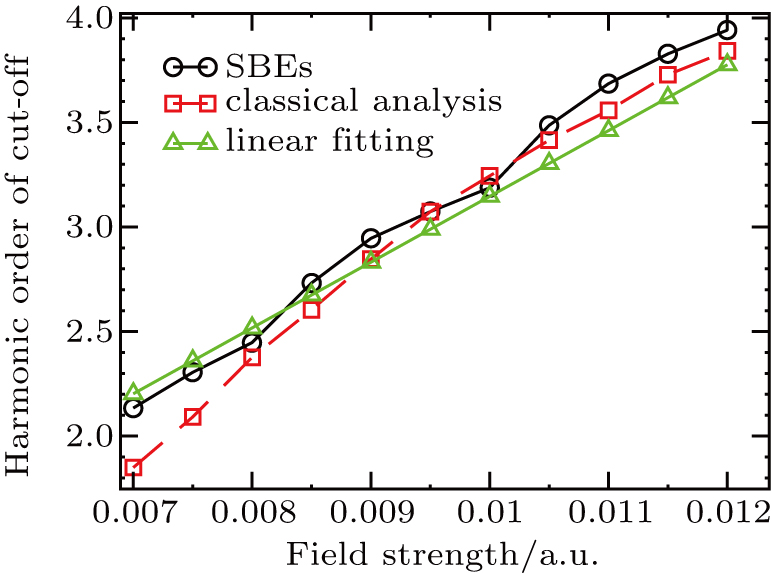 | Fig. 5. The cut-off energy of the second plateau, which is linearly rising along with the increase of the field strength from 0.007 a.u. to 0.012 a.u. |
Due to the BO-electron ultrafast dynamics in the extra harmonic plateau, the high harmonics generated from BO-electron could be the potential source of the isolated attosecond pulse. We show the attoseond pulses generated by 30 orders in the first harmonic plateau and the extra plateau in Fig.
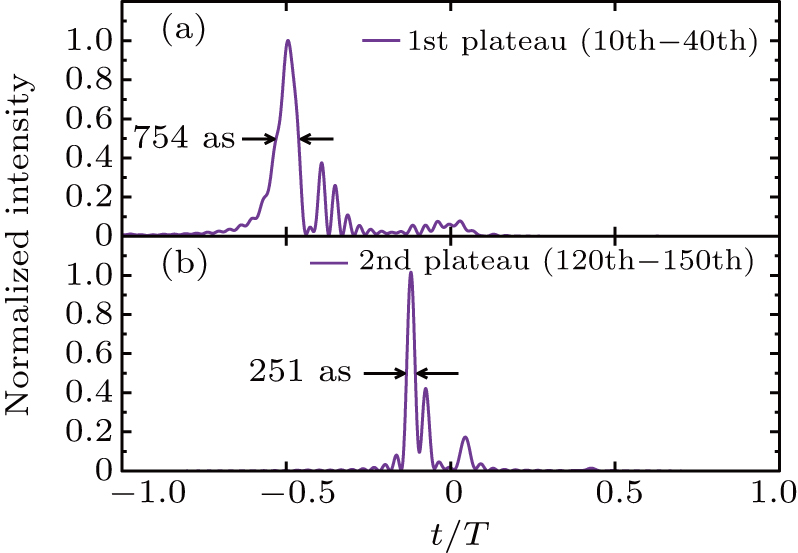 | Fig. 6. The attosecond pulse synthesis (a) from 10th order to 40th order harmonics of the first plateau, and (b) from 120th order to 150th order harmonics of the second plateau. |
We add a 1000 nm laser field with the FWHM of 1.875T, and the field strength maximum is 0.006 a.u. The 2-color laser field is shown in Fig.
We investigate the harmonic spectra from two-band SBEs and full-band TDSE, which agree well with each other. {In the two-band model,} the harmonic cut-off energy is limited by the bandgap between the two bands, and scales linearly with the field strength. The cut-off energy can be exactly estimated by the recollision model, which shows that the first plateau of the harmonics is produced by the recollision between the electron–hole pair. Increasing the field strength, we obtain an extra harmonic plateau, which shows the linear cut-off law with the field strength. When we compare the temporal electron population in momentum space with the time–frequency analysis, it shows that the time of higher-order harmonic emission is the moment when the Bragg scattering occurs. The harmonics in the extra plateau are induced by the BO-electron. We use an alternative description of BO, the WSL, to describe the mechanism of electron in real space. The trajectories of electrons in real space obtained from the classical analysis show that the electron can transit in the crystal sites of the WSL. The estimated cut-off energies from the representation in real space match well with the numerical results. The spectral width of the high-order harmonics is determined by the quiver distance of the electron in real space, which is related to the high frequency component of the dispersion. Then we take advantage of the ultrafast response of the BO-harmonics in the higher orders to obtain a 110 as isolated attosecond pulse in a 2-color laser field. BO-electron wave packet induced harmonic emission is a potential source of the shorter attosecond pulse generation.
In this model, the electrons are restricted within two bands, and the electrons undergo the Bloch oscillation instead of transiting to higher bands. We can realize the process in a realistic material, whose bandgap between the lowest and the second lowest conduction band is much higher than the bandgap between the first conduction band and the highest valence band.
| [1] | |
| [2] | |
| [3] | |
| [4] | |
| [5] | |
| [6] | |
| [7] | |
| [8] | |
| [9] | |
| [10] | |
| [11] | |
| [12] | |
| [13] | |
| [14] | |
| [15] | |
| [16] | |
| [17] | |
| [18] | |
| [19] | |
| [20] | |
| [21] | |
| [22] | |
| [23] | |
| [24] | |
| [25] | |
| [26] | |
| [27] | |
| [28] | |
| [29] | |
| [30] | |
| [31] | |
| [32] | |
| [33] | |
| [34] | |
| [35] | |
| [36] | |
| [37] | |
| [38] | |
| [39] | |
| [40] | |
| [41] | |
| [42] | |
| [43] | |
| [44] | |
| [45] | |
| [46] | |
| [47] | |
| [48] | |
| [49] | |
| [50] | |
| [51] | |
| [52] |


